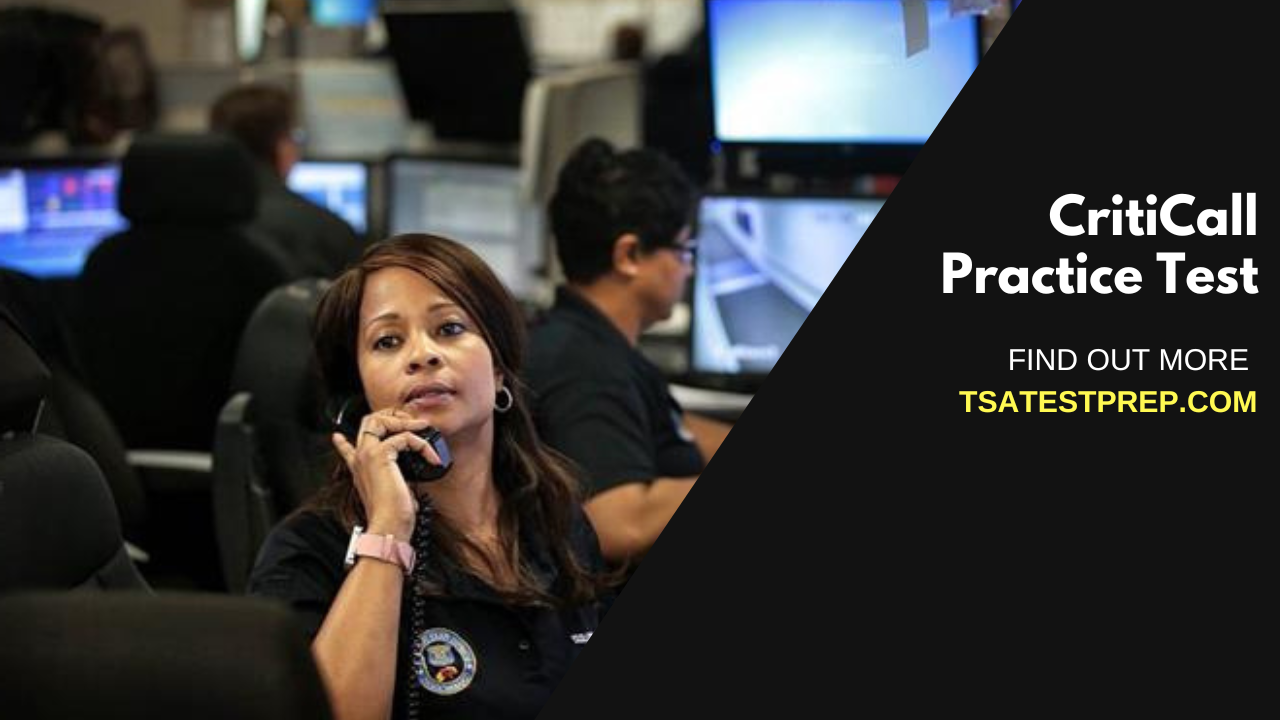
CritiCall Practice Test
If you are interested in a career as a 911 operator or dispatcher one of the first hurdles in the recruitment process is the CritiCall Test. Becoming a 911 dispatcher offers a satisfying career where you can potentially save lives, while also giving you job security and opportunities for career advancement. Dispatchers often enjoy competitive benefits, a varied work environment, and a sense of accomplishment that comes with handling challenging situations. For these reasons the selection process for the position is very competitive. We are here to walk you through everything you need to know about the CritiCall Test.
Take a Practice CritiCall Test.
What Is a CritiCall Dispatcher Test?
The CritiCall Test is a tool used by emergency services agencies during the recruitment process to measure a job applicant's potential success in positions such as 911 operators and dispatchers. The point of the exam is to see whether candidates have the skills that are needed to succeed in the high pressure job. Applicants need to show that they have the capacity for decision-making, multitasking, and prioritization during stressful situations. There are 25 different varieties of module options that may appear on your CritiCall exam. Most agencies use between 10-15 common modules for the assessment. The most popular modules on the CritiCall Test include:
Data Entry
In this module candidates are evaluated on their accuracy and speed in entering information into a computer system.
Call Summarization
In this module candidates listen to recorded emergency calls and then summarize the critical information from those calls.
Cross-Referencing
In this module candidates are asked to match information from databases or documents to respond to specific scenarios or inquiries.
Decision Making
In this module candidates are presented with emergency scenarios and must make quick decisions on how to respond appropriately.
Memory Recall
In this module candidates are tested on their ability to remember and recall details from previously presented information.
Map Reading
In this module candidates must navigate through maps or use geographical information to respond to location-related questions.
Prioritization
In this module candidates are tested on their ability to prioritize tasks and calls based on their urgency and severity.
Character Comparison
This module evaluates your attention to detail by asking you to compare and identify similarities or differences between characters or strings of characters.
Reading Comprehension
This module assesses your understanding of written passages. You will be asked various questions related to the content of different written information you may require on the job.
Typing (Keyboarding)
This module evaluates your typing skills, focusing on both speed and accuracy in entering data using a computer keyboard. It's an integral skill needed to record information quickly and precisely in emergency settings.
Spelling
This module assesses your proficiency in spelling. You will be required to correctly spell words or identify the accurate spelling of a given word.
Math
This module evaluates your math skills. You may encounter tasks that involve fundamental arithmetic or require you to solve problems related to time, distance, or other numerical data.
Practice now with a Full Length CritiCall Practice Test.
FREE CritiCall Practice Test Questions, Answers, and Explanations
Critical Data Entry Practice Question
Directions: Fill in the displayed fields according to the information on the left side of the screen. At the same time, you must respond to emergency situations and redirect callers to the most relevant government agency: Police, Fire, EMS, or Utility.
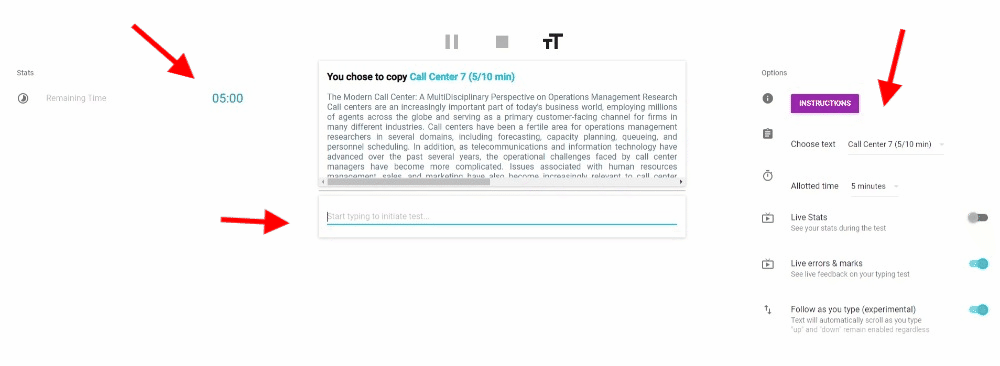
INSIDE TIP: This task is particularly HARD because of the time crunch. You have only 15 seconds, in which time you need to complete the form, capture critical details, and address incoming messages SIMULTANEOUSLY. Success in this module is all about multi-tasking in a short time period. To truly understand the experience, take a look at this CritiCall Practice Test which mimics the exact time limitations and experience of the actual exam.
CritiCall Call Summarization Practice Question
Listen to the following recording then answer the questions below.
1. How many vehicles does the caller think are presently at the intersection?
- 9
- 9, and possibly more
- 2
- 2, and possibly more
Answer + Explanation
The correct answer is (B)
In the recording we hear the man say:
"I can’t see clearly… I can recognize 9 right now, but maybe there are more."
2. What kind of car does the caller have?
- Toyota Camry
- Jeep Wrangler
- Volkes Wagon Van
- Honda Civic
Answer + Explanation
The correct answer is (C).
In an emergency situation knowing what type of car the person is driving would be a key factor to help save them. So when listening to a recording try and repeat important details to yourself to help you remember.
3. What should the passenger do if water starts to flood the car?
- Lock all doors and windows to create a seal
- Get on top of the vehicle if the water levels rises
- Try and pull over to higher ground
- Stay put
Answer + Explanation
The correct answer is (B).
If water levels are rising to a dangerous point you do not want to stay in the car as the water may flood. You also want to avoid driving. The best thing you can do is get to the highest point on top of the car.
CritiCall Cross-Referencing Practice Question
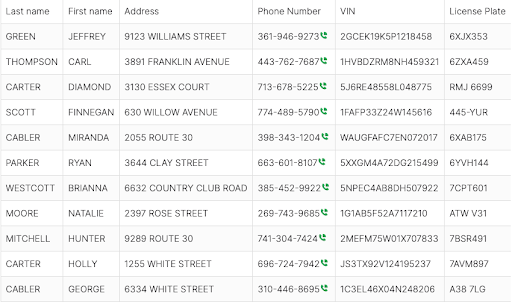
1. What's the last name of the person whose License Plate number is A38 7LG?
- George
- Cabler
- Mitchell
- Miranda
Answer
The correct answer is (B), Cabler
2. What is the phone number of the person living on Essex Court?
- 663-601-8107
- 713-678-5225
- 741-304-7424
- 269-743-9685
Answer
The correct answer is (B), 713-678-5225
3. What is the first name of the person whose VIN starts with 5J?
- Ryan
- Brianna
- Parker
- Diamond
Answer
The correct answer is D, Diamond.
CritiCall Decision Making Practice Question
1. A caller reports a strong smell of natural gas inside a residential building and believes it might be a gas leak. There are no visible flames, injuries, or medical concerns. Which unit would you assign?
- Police
- Fire
- EMS
- Utility
Answer + Explanation
The correct answer is D, Utility.
In this situation, the primary concern is a potential gas leak, which falls under the domain of utility services responsible for addressing issues related to natural gas supply. While the situation is not a medical emergency (no injuries or medical concerns) and does not involve fire or law enforcement matters, it does require the expertise of utility personnel to assess and mitigate the gas leak. Therefore, assigning the utility unit is the most appropriate response to ensure the safety of the area and prevent a potential gas-related incident.
2. A person is locked inside a car on a hot summer day, and they are visibly distressed. The car is parked in direct sunlight, and there is no immediate danger such as a fire or medical emergency. Which unit would you assign?
- Police
- Fire
- EMS
- Utility
Answer + Explanation
The correct answer is (B) - The fire department.
In this situation, the person is trapped inside a hot car, which can quickly become life-threatening due to the risk of heatstroke and suffocation. The Fire Department is often equipped to handle vehicle extrications, which can include safely opening a locked car to rescue someone in distress. While it's not a fire-related emergency, the fire department's specialized tools and training make them the appropriate unit to respond and ensure the safety of the individual trapped in the car.
INSIDE TIP: Do not rely on prior knowledge when answering decision making questions. Apply the principles outlined for the exam by studying in advance. Learn more in this CritiCall Test Study Guide.
CritiCall Memory Recall Practice Question
Click the play button and listen to the sequence of letters and numbers. Then write down the sequence as you heard it after the recording ends.
Answer
The answer is "JS97QR".
Answer
The answer is "NUKW5C".
CritiCall Map Reading Practice Question
Answer the questions below based on the this map:
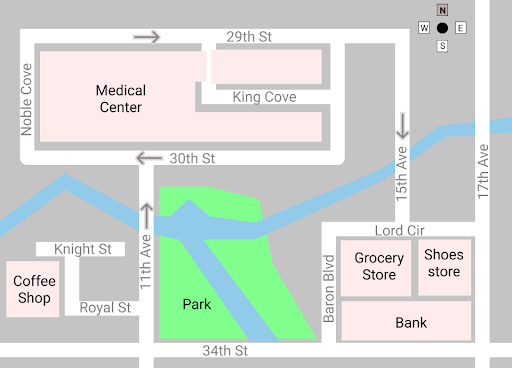
1. A man passed out at a convenient store on Lord Cir. A dispatcher ambulance is currently parked on the narrow street next to the medical center, between 29th St and King Cove.
- Exit to 29th St and head east. Take the second southbound turn onto 15th Ave, and then make a left onto Lord Cir.
- Exit to King Cove St and head east. Turn north, then east onto 29th St. Follow this road south to 15th Ave and make a right onto Lord Cir.
- Exit to 29th St and drive east. Take the second southbound turn onto 15th Ave, and then make a right onto Lord Cir.
- Exit to King Cove St and drive east. Turn right, then right again onto 30th St. Make a left onto 11th Ave and continue until you reach the grocery store.
Answer + Explication
The correct answer is (C). Exit to 29th St and drive east. Take the second southbound turn onto 15th Ave, and then make a right onto Lord Cir.
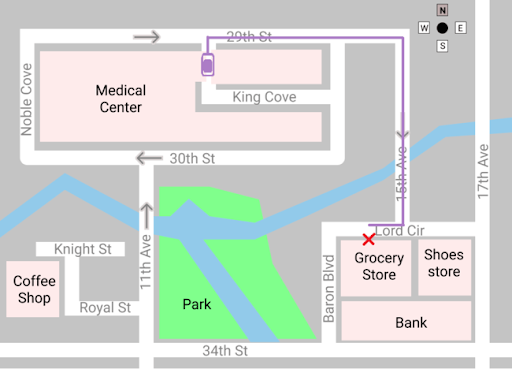
Option C provides the most direct route to the Lord Cir entrance of the grocery store. It involves exiting to 29th St and heading east, taking the second southbound turn onto 15th Ave, and then making a right turn onto Lord Cir. This route minimizes unnecessary turns and keeps the ambulance on a relatively straightforward path to reach the destination.
2. What is the shortest route from the cafe's western entrance to the intersection of Third Downhill Street while adhering to traffic signs?
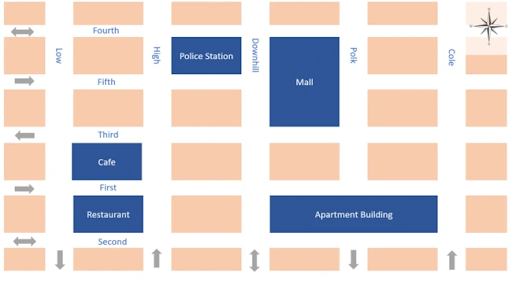
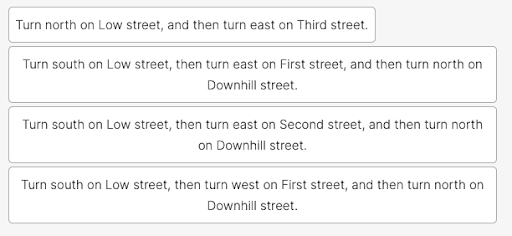
Answer + Explication
The correct answer is (B), Turn south on Low street, then turn east on First street, and then turn north on Downhill street.
To reach the intersection of Third and Downhill Street from the cafe's western entrance, follow this direct route: turn left (south) onto Low Street (a one-way street), proceed left (east) onto First Street (another one-way street), and then make a left (north) onto Downhill Street (a two-way street).
CritiCall Prioritization Test Question
Which situation requires the highest level of urgency?
- A motor vehicle collision on a busy highway involving multiple vehicles with reports of severe injuries and entrapment.
- A chemical spill in a factory has resulted in the release of toxic fumes, and several employees are reporting difficulty breathing and skin irritation.
- A residential fire with visible flames and people trapped inside the burning building.
Answer + Explication
The correct answer is (2).
In prioritizing emergency situations, it's crucial to consider the level of immediate danger and potential harm to individuals involved. The following diagram will help you decide which scenario is more urgent:

- Scenario 1 involves a motor vehicle collision with multiple vehicles and reports of severe injuries and entrapment. While it's a critical situation, it falls under the category of a Code 1 emergency.
- Scenario 3 represents a residential fire with visible flames and people trapped inside, which is also a Code 1 emergency due to the immediate life-threatening nature.
- Scenario 2, on the other hand, involves a chemical spill with toxic fumes that are causing immediate harm to employees. Toxic chemical exposure can result in severe health consequences, and it requires the highest level of urgency, often classified as a Code 0 or Alpha emergency, depending on local protocols.
Therefore, Scenario 2, the chemical spill with toxic fumes and injured employees, requires the highest level of urgency due to the immediate health risks posed by the toxic exposure.
CritiCall Character Comparison Test Question
Identify which of the following options is an exact copy of:
5544889900112233 Emily Davis
- 5544889900112233
- 5544889900221133
- 5544889900112234
- 5544889900112333
Answer
The correct answer is (A), 5544889900112233.
CritiCall Reading Comprehension Practice Question
Answer the questions below based on the following text:
Lots of people start running in their 30s or older, and it is one of the few sports in which you can improve with age. One example is the great Jack Foster, a self-styled "ancient marathoner", who ran for the first time at the age of 32, and by the age of 40 found himself picking up a silver medal at the Christchurch Commonwealth marathon in 1974.
Of course, while we all may hold secret hopes of uncovering a latent talent, most of us are unlikely to progress to an elite level. But, whether we like to compete on a weekend or prefer to go on solitary excursions through the countryside, the message is that age is far less of a barrier in running than it is in other sports. With running, even if taken up later in life without any previous experience, it really is realistic to expect improvement with age.
1. Which of the following best summarizes the main idea of the second paragraph
- It describes people's hopes to uncover their talents.
- It compares solitary runners to competitive runners.
- It highlights the message that running has no age.
- It emphasizes the importance of running when one is older.
Answer + Explication
The correct answer is C.
To answer this question, we must read paragraph 2 carefully. Once we do, we can see that the answer is evident in the paragraph, starting with the words: "The message is…" The message of this paragraph is that running has no age, and therefore answer choice (C) is the correct answer.
2. Based on the text, which of the following is definitely correct?
- Many people start running at an older age.
- Older runners generally receive more medals.
- More people prefer to compete than to run alone.
- Older runners are faster than younger runners.
Answer + Explication
The correct answer is A.
In order to conclude which of the statements is definitely correct, we must locate them in the text and find which of them is explicitly mentioned there:
Answer choice (A) - The passage begins with the words: "Lots of people start running in their 30s or older…", corresponding with this answer choice and confirming it as correct.
Answer choice (B) - While it is true that Jack Foster received a medal for his running achievements, we don't actually know whether older runners receive more medals than younger runners. This is not necessarily a correct statement.
Answer choice (C) - The second paragraph describes two types of runners: people who like to participate in races and those who like to run without competing. It does not, however, compare the number of runners per category. Thus, this answer choice is not necessarily correct.
Answer choice (D) - Again, like answer choice (B), we do not have information regarding the qualifications of younger versus older runners. Therefore, this answer choice is also not necessarily correct. Therefore answer choice (A) is the correct answer.
3. Which one of the following is definitely true regarding Jack Foster, based on the text?
- He ran in his 20s.
- He ran a marathon.
- He is from Christchurch.
- He is stylish.
Answer + Explication
The correct answer is (B), He ran a marathon.
To conclude which of the statements is definitely true, we must locate them in the text and find which one of them is explicitly mentioned there. In this case, it is easy to locate the section in the text corresponding to the answer choices, as the question provides us with a clue ("Jack Foster") leading us to our answer. This is the section that refers to Foster:" One example is the great Jack Foster, a self-styled "ancient marathoner", who ran for the first time at the age of 32, and by the age of 40 found himself picking up a silver medal at the Christchurch Commonwealth marathon in 1974". It is said that Foster: (1) ran for the first time at the age of 32 – this eliminates answer choice (a). (2) ran a marathon in Christchurch – however, we do not know if he actually lived there, thus eliminating answer choice (c). (3) he is a self-styled "ancient marathonist,"- which does not mean he is stylish, eliminating answer choice (d). Since the text states explicitly that Foster ran a marathon, answer choice (b) is thus the correct answer.
CritiCall Typing Test Practice Question
During the Dispatcher Typing Test, you will be required to accurately and swiftly retype a provided text passage within a 5-minute timeframe. It's essential to prioritize both speed and precision, as any errors made or corrections performed will influence your ultimate score. Here's an example from a Dispatcher typing practice test:
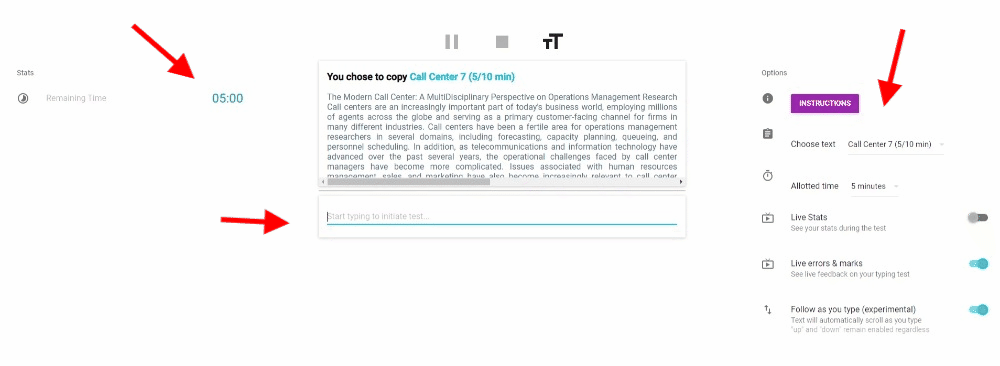
Inside Tip: For the Dispatcher typing test, practice to enhance your typing speed (WPM) and accuracy. A recommended typing speed for 911 dispatcher candidates is 35 WPM or higher, sustained for at least 5 minutes. We recommend using this Typing Practice which exactly mimics the test. It is essential to boost your speed and efficiency.
CritiCall Spelling Question
Choose the correct spelling to complete the sentence:
The _______________ rainfall in this region can lead to severe flooding.
- percipitate
- precipatate
- precipitate
- precepitate
- None of these
Answer + Explication
The correct answer is (C), precipitate.
The correct spelling for the sentence is "The precipitate rainfall in this region can lead to severe flooding." "Precipitate" means to cause or bring about suddenly, which fits the context of the sentence. The other options contain spelling errors.
CritiCall Math Practice Question
A car travels along a winding mountain road, covering a distance of 86.5 miles. If it maintains an average speed of 43.25 miles per hour, how long will it take the car to complete the journey?
- 2 hours
- 3 hours
- 4 hours
- 5 hours
Answer + Explication
The correct answer is (C), 4 hours.
To calculate the time it takes to complete the journey, you can use the formula:
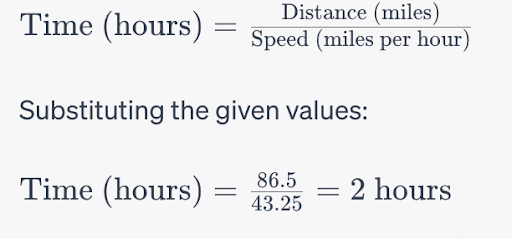
So, it will take the car approximately 4 hours to complete the journey.
As you can see the CritiCall Test is both length and Intricate. Take a FULL LENGTH CritiCall Practice Test to know exactly what to expect on the test day.
CritiCall Test FAQs
What Do I Need to Know Before Taking the CritiCall Test?
One essential skill needed of a public safety communications employee is the ability to make decisions based on established guidelines. During the CritiCall DispatcherTest, you will be presented with scenarios in which you must promptly and accurately determine which type of agency (e.g Police, Fire, Emergency Medical Service, or Public Utility Company) should respond to the incident, based on a specific set of rules. Before taking the test, you should thoroughly REVIEW and familiarize yourself with these rules:
- Police: The Police Department should be contacted when there is an immediate threat of physical harm to an individual, an actual physical harm incident, or when an individual is actively causing damage to another person's property.
- Fire: The Fire Department should be alerted in the presence of clear signs of an ongoing fire, such as flames or smoke, upon activation of a fire alarm, or when there's a need to rescue or release a person who is trapped or confined.
- EMS: Emergency Medical Services (EMS) should be dispatched when there is a medical emergency that requires intervention from trained medical personnel.
- Utility: Public Utility services should be requested when there are issues related to the malfunction or damage of public water systems, natural gas systems used for residential heating, electric power systems (including items like electrical power lines, streetlights, and traffic signals), or obstructed sewer drain pipes.
It's Important to note that these rules have been developed for the CritiCall Test alone and do not necessarily reflect the official policies of public safety agencies.
INSIDE TIP: When making decisions during the test, avoid relying on your prior knowledge of this agency or any other. Instead, exclusively use the decision rules above. Review some sample CritiCall Decision Making Questions.
How Is the CritiCall Test Scored?
Your CritiCall test is scored based on three key metrics: Keystrokes-per-Hour (KPH), Words-per-Minute (WPM), and section-specific percentage scores (%). These three metrics are combined to calculate an overall score, given in terms of a percentage. Do not expect your Words-Per-Minute score on the dispatcher typing test to be the same as when you type regularly.
What Score Do You Need to Pass the CritiCall Test?
The typical passing scores for the majority of sections in the CritiCall 911 Test fall within the 70% to 75% range. But, at some highly competitive agencies, achieving a cutoff score of 80% or even 90% may be required to pass the test. These benchmark cutoff scores are usually established by evaluating the performance of existing dispatchers and analyzing their scores.
Many agencies use the metrics below to calculate passing scores. These scores are not exact but rather a rubric to help guide you in your preparation.
Attention to Detail
| Section | Passing Score |
| Data entry with multi-tasking | 55-60 keystrokes per minute |
| Audio data entry with multi-tasking | 28-40 keystrokes per minute |
| Typing | 35 words per minute |
| Cross-referencing | 56%-70% |
| Character comparison | 70% |
Dispatcher Skills
| Section | Passing Score |
| Prioritization | 70% |
| Memory recall | 61%-70% |
| Map reading | 62%-70% |
Basic Skills
| Section | Passing Score |
| Call summarization | 57%-70% |
| Reading comprehension | 57%-60% |
| Spelling and sentence clarity | 68%-70% |
| Math | 70% |
What Happens if You Fail The CritiCall Test?
Failing the CritiCall Dispatcher Exam can have different consequences depending on the specific agency you are applying to. In some cases, if you fail the test, you may not be allowed to proceed further in the application process for the position you are applying for. This means that you will not be considered for the job. Other agencies may allow candidates to reapply and retake the test after six months, and others as soon as another position opens.
How Long Before I Get the Results of my CritiCall Test?
The time it takes to receive your score on the 911 CritiCall Test can vary depending on the specific agency or organization administering the test. On test day, some agencies will notify you of a test failure, while others will extend an invitation to proceed to the next stage of the hiring process. A smaller number will provide your precise scores for each section upon completion. Tests that include vocal components may take longer to score.
Is the CritiCall Test Hard?
The CritiCall Assessment Test is generally considered to be a difficult exam, especially for individuals who have no previous experience in emergency dispatching. The test was made to simulate the difficult tasks that dispatchers face on the actual job, and it measures a variety of skills that are crucial for success in the role. This makes it a great predictor of future success on the job.
Make sure you pass your CritiCall Test Get FREE Critical Exam Practice Test Questions.
Who Uses the CritiCall Test?
The CritiCall Examination is mostly used by emergency dispatch centers and call centers. Some of the specific agencies and organizations that commonly use the CritiCall test include:
Public Safety Answering Points (PSAPs)
PSAPs are call centers responsible for answering emergency calls, including 911 calls. They dispatch emergency services such as police, fire, and medical assistance.
Police Departments
Police agencies may use the CritiCall Police Dispatcher Test to assess candidates' suitability for various roles, including emergency call dispatchers.
Fire Departments
Fire departments often employ the CritiCall test to evaluate candidates for their communication and dispatch centers.
Emergency Medical Services (EMS) Agencies
EMS agencies may use the CritiCall test to evaluate candidates for positions in their communication centers, where they coordinate emergency medical responses.
Other Emergency Service Agencies
Other organizations involved in emergency response and public safety, such as search and rescue teams, may also use the CritiCall test in their hiring processes.
How Long Is the CritiCall Test?
The test usually lasts between two to three hours. The length of the test varies depending on the number of modules used by the testing agency. No matter what, the test is quite lengthy so come in prepared.
Do I Need 911 Dispatcher Experience Before the Test?
No! The CritiCall Pre-Employment Test is specifically designed to evaluate fundamental skills and abilities, rather than previous knowledge or experience. The point of the exam is to assess key aptitudes and competencies that are needed for effective performance in emergency dispatch or call center roles. That being said, we do advise taking a look at this FREE Practice 911 Dispatcher Test to see if you feel like you have the skills needed for the job.
How Can I Prepare for the CritiCall Test?
To prepare for the CritiCall Test, you can follow these tips:
- Practice using a physical keyboard: Since the CritiCall Typing Test is typically administered using a physical keyboard, it is important to be comfortable using one. Practice typing skills using a desktop keyboard with a Num Pad rather than a laptop.
- Familiarize yourself with the test format and content: The CritiCall Test consists of a number modules that assess different skills. Each agency will select the modules that are most relevant to them. It is essential to understand the test format and the specific skills assessed in each module.
- Understand there is no penalty for a wrong answer. This means you should not leave anything blank.
- There are both audio and text based questions. So make sure you are confident with both types.
We recommend taking a look at this Practice CritiCall Test which uses an accurate format and time frame for the various modules included on the exam. Unlike other exams, the CritiCall Test requires you to understand some basic principles before taking the exam and not to just rely on prior knowledge. That is why we advise using some sort of CritiCall Test prep before testing day.
Learn more about the the other 911 Dispatcher Tests and Get FREE 911 Dispatcher Practice Tests.

Have a Question? Now You Can Ask TSA Test Prep!